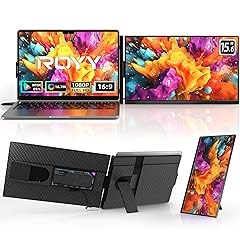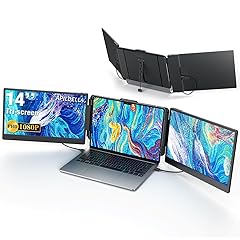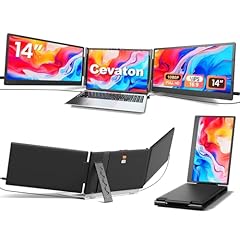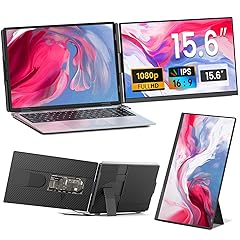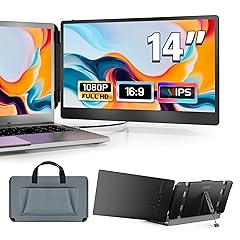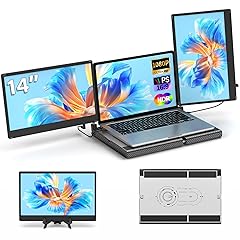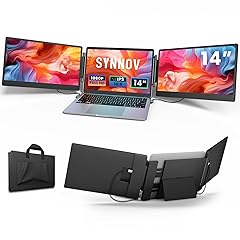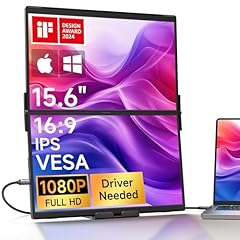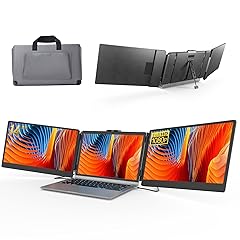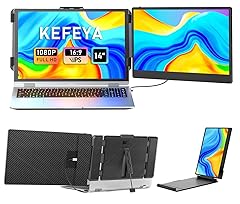-
1
Best Overall Easily attaches to laptops for extra screen space.
Easily attaches to laptops for extra screen space. High-quality 1080P FHD display with vibrant colors.
High-quality 1080P FHD display with vibrant colors. Compatible with multiple devices via USB-C/HDMI.
Compatible with multiple devices via USB-C/HDMI. -
2
Hot Deal Easy plug-and-play setup for quick use.
Easy plug-and-play setup for quick use. Compatible with both Mac and Windows.
Compatible with both Mac and Windows. Fits laptops ranging from 13” to 17.3”.
Fits laptops ranging from 13” to 17.3”. -
3
 Easy plug & play setup for convenience.
Easy plug & play setup for convenience. Compatible with multiple operating systems.
Compatible with multiple operating systems. Auto adjust feature for perfect fit.
Auto adjust feature for perfect fit. -
4
 Easy setup with plug and play functionality.
Easy setup with plug and play functionality. Compatible with multiple operating systems.
Compatible with multiple operating systems. Detachable design for convenient portability.
Detachable design for convenient portability. -
5
 Versatile compatibility with multiple devices.
Versatile compatibility with multiple devices. Easy plug and play setup.
Easy plug and play setup. Supports a range of laptop sizes.
Supports a range of laptop sizes. -
6
 Easy setup with plug-and-play functionality.
Easy setup with plug-and-play functionality. Versatile 360° rotation for optimal viewing.
Versatile 360° rotation for optimal viewing. Compatible with multiple operating systems.
Compatible with multiple operating systems. -
7
 Enhances productivity with triple screen capability.
Enhances productivity with triple screen capability. Built-in speakers for convenient audio access.
Built-in speakers for convenient audio access. Compatible with multiple operating systems.
Compatible with multiple operating systems. -
8
 Easy setup with plug-and-play functionality.
Easy setup with plug-and-play functionality. Lightweight design for enhanced portability.
Lightweight design for enhanced portability. Adjustable viewing angles for personalized comfort.
Adjustable viewing angles for personalized comfort. -
9
Popular Easy plug-and-play setup with multiple ports.
Easy plug-and-play setup with multiple ports. Dual speakers enhance audio experience.
Dual speakers enhance audio experience. Expands workspace efficiently with triple monitor setup.
Expands workspace efficiently with triple monitor setup. -
10
 Easy setup with plug-and-play functionality.
Easy setup with plug-and-play functionality. Compatible with multiple devices and platforms.
Compatible with multiple devices and platforms. High-quality 1080P IPS display for clear visuals.
High-quality 1080P IPS display for clear visuals.
Overview of Laptop Screen Extender
In today's fast-paced digital world, multitasking is essential, and having extra screen space can significantly enhance productivity. Laptop screen extenders are compact, portable solutions that allow users to expand their display real estate without the need for a separate monitor. Whether you're a student juggling multiple assignments, a professional managing numerous projects, or a creative seeking more room for design work, these devices can transform your laptop into a more efficient workstation. This guide will explore the best options available, helping you find the perfect screen extender to meet your needs and boost your workflow.Top Laptop Screen Extender
• ROYY Dual Monitor Laptop Screen Extender• Apildella Triple Laptop Screen Extender 14’’• Cevaton Laptop Screen Extender, 14" FHD Triple MonitorFAQ
Q: How do I connect a laptop screen extender to my laptop?
A: Connecting a laptop screen extender is usually straightforward. Most extenders use a USB, HDMI, or DisplayPort connection. Simply plug the extender into the appropriate port on your laptop, and it should be recognized automatically. You may need to adjust your display settings to extend or duplicate your screen.
Q: Can I use a laptop screen extender with any laptop?
A: Most laptop screen extenders are compatible with a wide range of laptops. However, it's essential to check the compatibility specifications, such as the required ports and operating system support, to ensure it will work with your particular laptop model.
Q: What are the benefits of using a laptop screen extender?
A: A laptop screen extender provides additional screen space, which can significantly enhance productivity by allowing you to multitask more efficiently. Whether you're working on multiple documents, attending video conferences, or conducting research, an extender helps you manage tasks without constantly switching windows.
Q: How can a laptop screen extender improve my gaming experience?
A: A laptop screen extender can enhance your gaming experience by providing a larger view and more immersive visuals. It allows gamers to enjoy a broader perspective, making it easier to spot details and navigate virtual environments, ultimately enriching the overall gameplay.
Q: Is a laptop screen extender portable for travel?
A: Yes, many laptop screen extenders are designed to be lightweight and compact, making them perfect for travel. They are easy to pack alongside your laptop, allowing you to maintain a dual-screen setup wherever you go, whether you're working remotely or traveling for leisure.

